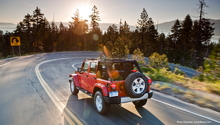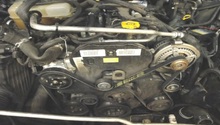Jeep Wrangler JK: 4WD Diagnostic Guide
The 4WD is what allows your Jeep Wrangler to be the ultimate off-road machine that it is. Learn how to diagnose it here.
This article applies to the Jeep Wrangler JK (2007-Present).
The Jeep Wrangler is designed to be an absolute reliable beast off the road. In order for it to drive without getting stuck off-road, the 4WD system has to be working properly. The 4WD system, like the engine, requires regular maintenance. Ignoring it completely can cause it to fail. 4WD issues come in a variety of shapes and forms, so it is important to know how to diagnose it and not confuse it with another component. This guide will shine some light on your 4WD and what you can do to diagnose an issue that arises with it. Read on to learn how you can diagnose some of your Jeep Wrangler's 4WD problems.

Material Needed
- Flashlight
Step 1 – Check for a leak
There could be a leak.
One of the most common issues in the 4WD system in the Jeep Wrangler is a leaking differential. Whether it's the front differential or the rear one, most of the time it doesn't affect the driving feel, so it is something you should do as a regular maintenance. It could however affect the feel of your 4WD lever and cause a loud grinding noise when you shift. To check that, use your flashlight to look around the front and rear differential for any signs of wetness. The leak could be coming from the drain bolt or the main seal around the assembly. If the main seal is leaking, you will have to reseal it completely.

If the differentials aren't leaking, proceed to Step 2.
Step 2 – Are you getting consistent grinding noise?
You could be misusing the 4WD.
Aside from grinding noise caused by low fluid in the differentials, you could get grinding noise by simply using the 4WD wrong. For instance, if you're switching between 4WD gears and you do it slowly, it could cause grinding noise. You should switch between the gears fast. The bigger issue is if you use your 4WD on dry pavement. Doing so could cause damage to your Jeep. When you engaged the 4WD, all four wheels get locked together for ultimate traction. However, when you turn on hard pavement, the wheels will try to turn at different speeds, but the 4WD will prevent that, which could cause damage to various components and not just the 4WD.

If that's not your problem, proceed to Step 3.
Step 3 – Is your 4WD lever not shifting?
It could be broken.
The 4WD lever is connected with a cable, when you pull the fancy lever, the cable moves the gears around. If your lever is stuck in place and you've tried everything to move it, it could mean your cable has broken. It is recommended you let a professional handle such case; however, if you plan on doing it yourself, you will need to remove the center console trim and follow the cable from the 4WD shifter to the transfer case.

Related Discussions
- Grinding Noise - JK-Forum.com
- Jumping Hard When Turning in 4WD - JK-Forum.com
- Proper Shifting into 4WD - JK-Forum.com






